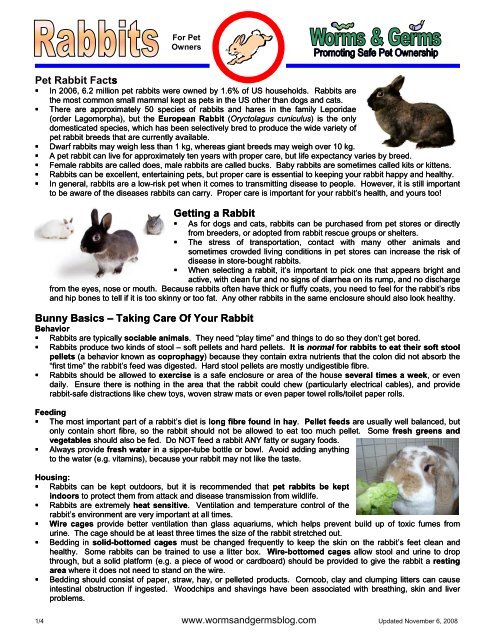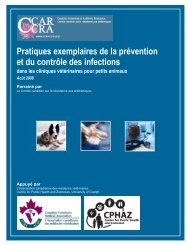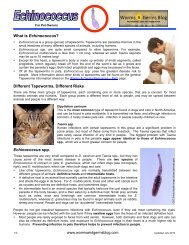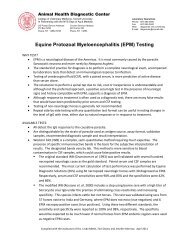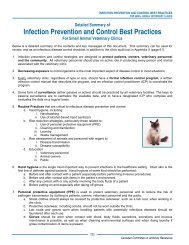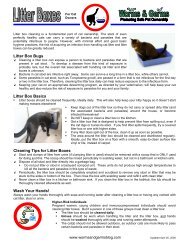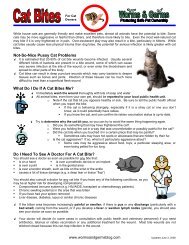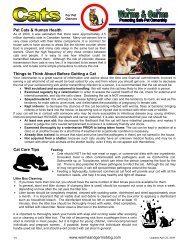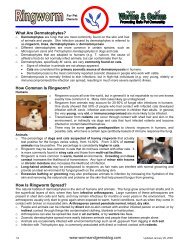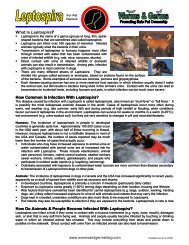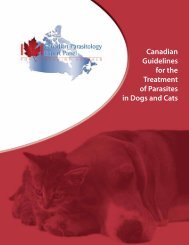Rabbits - Worms and Germs Blog
Rabbits - Worms and Germs Blog
Rabbits - Worms and Germs Blog
You also want an ePaper? Increase the reach of your titles
YUMPU automatically turns print PDFs into web optimized ePapers that Google loves.
Basic Veterinary Care• There are no vaccines licensed for use in rabbits in North America, although vaccination for myxomatosis <strong>and</strong> viralhemorrhagic disease is common in parts of Europe <strong>and</strong> Australia.• The intestinal bacteria of rabbits are very sensitive to many antibiotics. Misuse ofantibiotics in rabbits can cause very severe, often fatal, intestinal infection. Only giveyour rabbit medication that has been prescribed by your veterinarian.• <strong>Rabbits</strong> should be spayed or neutered at 4-6 months of age. This tends to make rabbitsless territorial <strong>and</strong> less aggressive. Female rabbits that are not spayed by two years ofage are at extremely high risk of cancer of the reproductive tract <strong>and</strong> mammary tissues.• A dental examination should be performed by your veterinarian as part of every general physical examination,because it can be very difficult to check your rabbit’s back teeth without special equipement.H<strong>and</strong>ling <strong>Rabbits</strong>It is very important that rabbits are h<strong>and</strong>led <strong>and</strong> held properly. A rabbit’s hind legs are sopowerful that if the animal kicks when it is not properly supported, the force can actuallybreak its back! If your rabbit feels safe, it will also be less likely to scratch or bite.• <strong>Rabbits</strong> can be picked up in a similar manner to cats, placing one h<strong>and</strong> between theforelegs <strong>and</strong> the other h<strong>and</strong> under the rabbit’s rump, which supports most of therabbit’s weight. The rabbit should be held firmly but gently, <strong>and</strong> close to the chest. Ifa rabbit is held too loosely or too tightly, it may begin to struggle or try to get away.• Never use the ears or scruff to pick up a rabbit. Always support your rabbit’sweight from beneath its rump <strong>and</strong>/or chest (see picture right).• Do not try to restrain the forelegs or especially the hind legs of a rabbit, in order toreduce the risk of a powerful kick causing a fracture of the spine.• A rabbit should always be placed in a cage or pet carrier hind end first, so that it doesnot try to jump out of the h<strong>and</strong>s of the h<strong>and</strong>ler.Rabbit Bites• All rabbits may bite. Bite wounds from rabbits may be small, but they can create deep puncture wounds.• All bite wounds should immediately be cleaned vigorously with large volumes of soap <strong>and</strong> water, <strong>and</strong> watchedclosely for signs of infection. Infection is usually caused by bacteria from the skin of the person bitten or therabbit’s mouth, including Pasteurella multocida, which can cause particularly serious infection.• Medical attention should be sought for any bite over a joint, h<strong>and</strong>, tendon sheath, prosthesis, implant or genitalarea, <strong>and</strong> for any bite to an immunocompromised individual (e.g. HIV/AIDS, transplant <strong>and</strong> cancer patients).Is My Rabbit Sick?• The most common signs of illness in a rabbit are likely lethargy <strong>and</strong> decreasedappetite. Other things that may indicate your rabbit is sick include: Bloating, or changes in the colour or consistency or amount of stool Not moving around normally, especially problems with the hind legs A significant change in behavior, such as becoming very aggressive Drooling or teeth-grinding Difficulty urinating• <strong>Rabbits</strong> fed diets with insufficient long fibre (hay) may develop diarrhea or constipation, <strong>and</strong> frequently chew hair.• If you notice any of these signs or if you have any other concerns about your rabbit, contact your veterinarian assoon as possible. Veterinary care may seem expensive compared to the cost of a rabbit, but it is very important torule out infectious diseases, especially if there is a high-risk person on the household, such as a young child or aperson with a weakened immune system. It is also very important not to let the rabbit suffer as it gets more sick.Illnesses in rabbits may also be due to feeding or housing problems.Can My Rabbit Make ME Sick?<strong>Rabbits</strong> are not frequently involved in transmission of disease to people. Nonetheless, each ofthe following diseases or pathogens may on occasion be carried by rabbits <strong>and</strong> potentially betransmitted to humans. Please refer to specific disease information sheets for more details.Salmonella sp., Escherichia coli, Clostridium difficile: These bacteria have all been associated with intestinal infections <strong>and</strong> diarrhea in rabbits, <strong>and</strong> can potentially betransmitted to humans by stool contamination of food or water, or contamination of h<strong>and</strong>s followed by transfer to2/4 www.worms<strong>and</strong>germsblog.com Updated November 6, 2008
the mouth. Salmonella carriage occurs in even healthy animals of many species, <strong>and</strong> can likely occur in healthyrabbits as well, so it is prudent to take precautions (see below) when h<strong>and</strong>ling rabbit stool <strong>and</strong> soiled bedding inparticular. Intestinal infection or diarrhea of any kind in rabbits can be very serious, <strong>and</strong> requires prompt attention.Dermatophytosis (ringworm): A fungal skin infection caused by one of several species of Microsporum or Trichophyton. Humans may developwell-delineated areas of red, raised, itchy skin that are often lighter in the centre <strong>and</strong> therefore appear as a “ring.”The fungi are transmitted by contact with the skin, fur or d<strong>and</strong>er of an infected animal, particularly if the person’sskin is damaged or moist. Signs of dermatophytosis in rabbits can range from none at all, to patches of hair loss<strong>and</strong> red, dry, scaly skin that are often itchy.Encephalitozoonosis: An infection caused by microscopic parasites of the genus Encephalitozoon. Encephalitozoonosis is rare inpeople with normal immune systems, but is quite common in people with weakened immune systems (e.g.HIV/AIDS, cancer or transplant patients). The species E. cuniculi can be found in many animal species, includingrodents, dogs, cats, horses, pigs <strong>and</strong> particularly rabbits. “Spores” of the parasite are typically found in the urine ofinfected rabbits, <strong>and</strong> can cause infection if they are swallowed. In most rabbits there are no signs of infection, butthe parasite can affect the brain <strong>and</strong> kidneys of people <strong>and</strong> rabbits. No human cases have been directly linked tocontact with an infected rabbit, but due to the severity of disease caused by the parasite, caution is warranted.Mange due to Cheyletiella parasitivorax: Cheyletiella parasitivorax is a common mite of domestic rabbits that can also infect cats <strong>and</strong>dogs. It can also temporarily infest humans, causing mild skin inflammation. Infection inrabbits often causes no clinical signs or partial hair loss with only mild skin inflammation.Rabies: A viral infection of the nervous system which is almost always fatal once clinical signs appear.Transmission occurs when the saliva of an infected animal comes in contact with a wound(such as a bite or scratch) or mucous membrane (e.g. eyes, nose, mouth). <strong>Rabbits</strong> areusually killed if they are bitten by a rabid animal, but rabbits can be infected by bats. <strong>Rabbits</strong>can also survive attack by larger rabid animals (<strong>and</strong> become infected) if they are partially protected in anenclosure. Confirmed cases of rabid rabbits biting humans have not been reported, but post-exposure prophylaxishas been recommended in some cases following non-bite contact with rabid rabbits in the USA.Tularemia (“rabbit fever”): A bacterial infection caused by Francisella tularensis. It is most commonly found in wild animals such as rabbits,hares, <strong>and</strong> rodents. The major reservoir host in North America is the cottontail rabbit (Sylvilagus floridanus). Themajority of infections in the USA likely occur due to insect bites (e.g. ticks, flies), or h<strong>and</strong>ling infected wildlife/game.Infection in people <strong>and</strong> animals may cause no signs, flu-like signs, very swollen lymph nodes, severe diarrhea orpneumonia. The bacteria themselves are highly infectious (it only takes 10-50 bacteria to infect a person).Other “Zoonotic” Diseases of <strong>Rabbits</strong><strong>Rabbits</strong> can occasionally be infected with Giardia duodenalis <strong>and</strong> Cryptosporidiumspp., which can potentially infect humans, but transmission of these pathogens fromrabbits to people has not been reported. <strong>Rabbits</strong> can also be infected withToxoplasma gondii <strong>and</strong> larvae of Baylisascaris procyonis (raccoon roundworms), butthey cannot transmit these parasites. There are also no reports of human infestationwith Sarcoptes scabiei (which causes sarcoptic mange) acquired from rabbits. Rabbitear mites (Psoroptes cuniculi) are not known to infest humans.Pasteurella multocida is a common cause of upper respiratory disease (“snuffles”) in rabbits. This pathogen cancause respiratory infections in humans, <strong>and</strong> could theoretically be transmitted from an infected rabbit, but people aremuch more likely to develop pasteurellosis from a rabbit in the form of an infected bite wound.Infection ControlAlthough rabbits are generally low-risk in terms of their potential to transmit disease to humans,there is always some risk. The risk of illness in a rabbit <strong>and</strong> transmission of zoonoticpathogens to people can be reduced by proper h<strong>and</strong>ling, good management, personal hygiene<strong>and</strong> routine healthcare. A rabbit that is not stressed <strong>and</strong> is well cared for is less likely to besusceptible to infection, <strong>and</strong> therefore less likely to transmit infection to a person.• Prolonged close contact with a rabbit, such as allowing the animal to sleep in the same bedas a child, should not be permitted. Anyone h<strong>and</strong>ling a rabbit, especially children, shouldbe taught how to do so correctly <strong>and</strong> as safely as possible.3/4 www.worms<strong>and</strong>germsblog.com Updated November 6, 2008
H<strong>and</strong> Hygiene• H<strong>and</strong>s should be thoroughly washed with soap <strong>and</strong> running water, or an alcohol-based h<strong>and</strong> sanitizer should beused, after h<strong>and</strong>ling a rabbit, cleaning a rabbit’s cage, or coming into contact with rabbit bedding, stool or urine.• Children should be supervised by an adult to ensure that this is done properly.Cleaning Up• A rabbit’s enclosure should be checked daily for build up of stool <strong>and</strong> urine in the bedding. Stool should bescooped out daily or every other day, even if the rabbit uses a litterbox.• The entire enclosure should periodically be thoroughly cleaned, including removal of all bedding <strong>and</strong> disinfection ofthe cage itself. Some rabbits may need to have their cages cleaned out more frequently than others. All old bedding should be removed <strong>and</strong> the inside of the cage should be scrubbed withsoap <strong>and</strong> water, using a stiff-bristled brush to remove any remaining excrement/debris thatmay be adhered to the surface. Once the cage looks clean, a household disinfectant (e.g. bleach (diluted 1:9 with water))should be applied. The disinfectant should be left in contact with all surfaces for at least10 minutes, followed by thorough rinsing with water. Allow the cage to dry completelyprior to filling it with clean bedding.• H<strong>and</strong>s should always be washed thoroughly with soap <strong>and</strong> water after cleaning the cage. Immunocompromisedindividuals (e.g. HIV/AIDS, transplant or cancer patients) should try to have someone else clean their rabbit’s cagefor them if possible.• Food bowls <strong>and</strong> water bottles should also be cleaned daily, <strong>and</strong> thoroughly washed with hot soapy water weekly,in order to prevent build up of bacteria on these objects. Any fresh produce that are not eaten promptly by therabbit should be removed from the cage in order to prevent spoilage.For healthy adults <strong>and</strong> older children (over 5 years old), the risk of contracting a disease from a pet rabbit is:LOW RISKHEALTHY ADULTS / OLDER CHILDREN1 2 3 4 5 6 7 8 9 10HIGH RISKGroups at higher risk of acquiring a zoonotic disease from pets, including rabbits, are immunocompromisedindividuals (e.g. HIV/AIDS, transplant <strong>and</strong> cancer patients), infants, young children less than five years of age, <strong>and</strong>the elderly. Nonetheless, pet ownership can have significant emotional benefits for members of these groups. Withselection of an appropriate pet <strong>and</strong> close attention to infection control measures, the risk can be significantly reduced.For rabbits living with high-risk individuals, important points to consider include the following:• Be diligent <strong>and</strong> thorough about h<strong>and</strong> washing after h<strong>and</strong>ling the animal or cleaning its cage. High-risk individuals should try to have someone else clean the rabbit’s enclosureregularly. Otherwise the person should wear rubber gloves when cleaning theenclosure <strong>and</strong> be very diligent about washing his/her h<strong>and</strong>s when finished.• Keep the rabbit away from food preparation areas <strong>and</strong> food meant for human consumption.• Know how to h<strong>and</strong>le a rabbit correctly (in a calm, gentle manner), <strong>and</strong> only h<strong>and</strong>le theanimal when necessary to minimize the risk of bites or scratches.• Keep the rabbit in good health through proper management <strong>and</strong> veterinary care.For these groups, the risk of contracting a disease from a pet rabbit is likely:LOW RISKYOUNG CHILDREN / IMMUNOCOMPROMISED PERSONS1 2 3 4 5 6 7 8 9 10HIGH RISKAdditional Information:• House Rabbit Society homepage. http://www.rabbit.org/4/4 www.worms<strong>and</strong>germsblog.com Updated November 6, 2008


